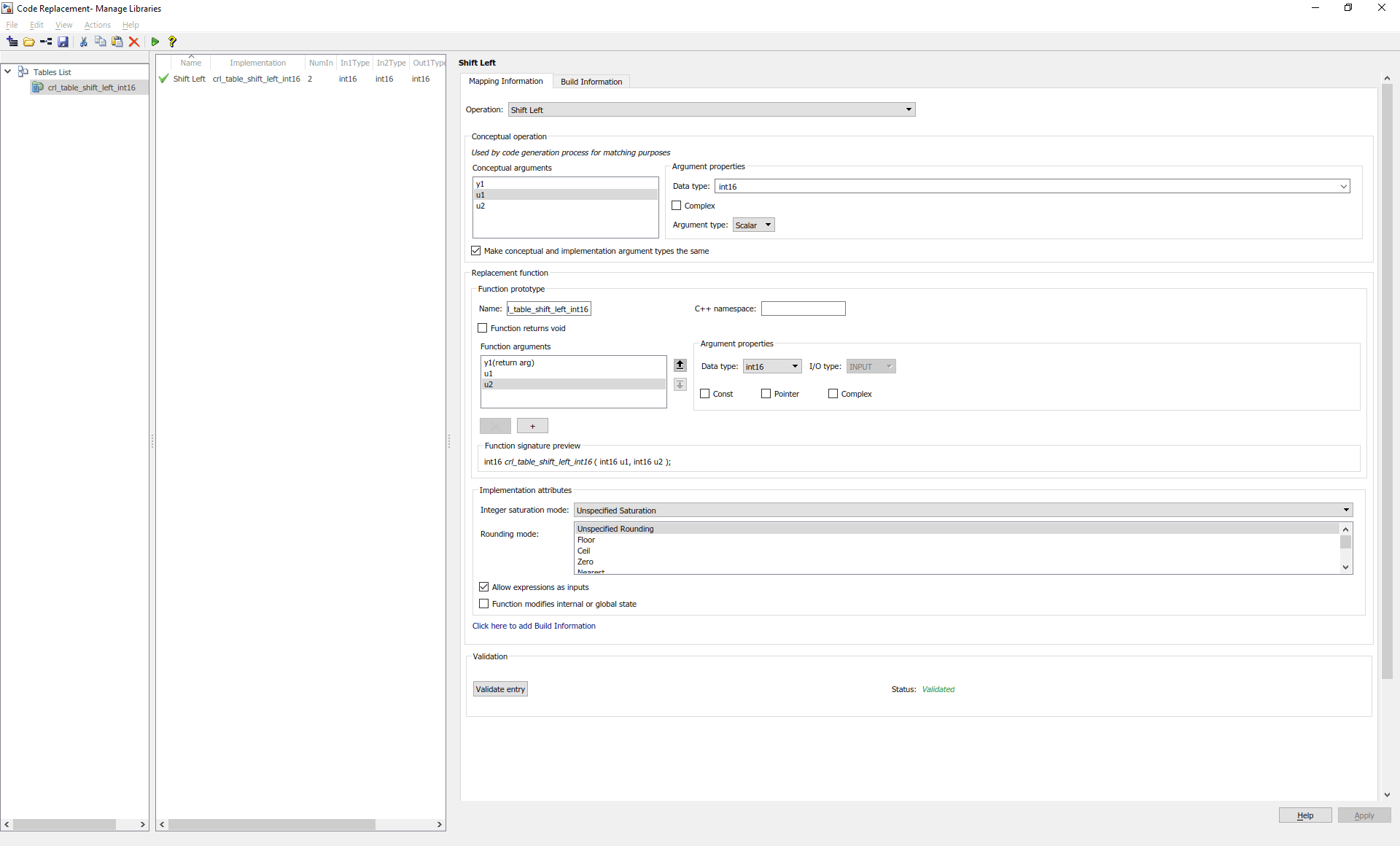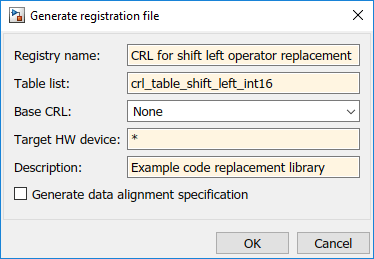Shift Left Operations and Code Replacement
This example shows how to develop a code replacement library to optimize the
performance of shift left (<<)
operation by providing information on how to define code replacement for a shift
left function. To develop a code replacement library use either the interactive
or programmatic approach. For more information, see Develop a Code Replacement Library.
Interactively Develop a Code Replacement Library
Open the Code Replacement Tool (crtool), from the MATLAB command line with the following command:
>>crtool
Create a table.
From the toolstrip of the Code Replacement tool, click New > Table.
In the right pane, name the table
crl_table_shift_left_int16. Click Apply.
Create an entry. Click New > Entry > Math Operation Entry.
Create entry parameters. In the Operation drop-down list, select
Shift Left.Create the conceptual representation. The conceptual representation describes the signature of the function that you want to replace. In the Conceptual function subsection of the crtool, specify the return argument,
y1, and the input arguments,u1, andu2, with Data Type ofint16and the Argument Type ofscalar.Create the implementation representation. The implementation representation describes the signature of the optimization function. For this example, to specify that the implementation arguments have the same order and properties as the conceptual arguments, select the Make conceptual and implementation argument types the same check box.
Under Function prototypespecify the Name for the replacement function as
my_shift_left.Specify build information. Click the Build Information tab to open the build requirements pane. Specify the files (source, header, object) that the code generator requires for code replacement. For this example, you do not need to specify build information.
Validate and save the table. Click the Mapping Information tab and verify the fields are filled in as shown. Click Apply, then click Validate entry. On the toolstrip, click Save and save the table.

Register a code replacement library. Registration creates a library composed of the tables that you specify. Click Generate Registration File. In the Generate registration file dialog box, fill in these fields:
Registry name —
CRL for shift left operator replacementTable list —
crl_table_shift_left_int16Base CRL —
NoneTarget HW device —
*Description —
Example code replacement library

Click OK. To use your code replacement library, refresh your current MATLAB session with the command:
>>sl_refresh_customizations
Verify the code replacement library. From the MATLAB command line, open the library by using the Code Replacement Viewer and verify that the table and entry are correctly specified. For more information, see Verify Code Replacement Library. Configure your model to use the code replacement library, generate code, and verify that replacement occurs as expected. If unexpected behavior occurs, examine the hit and miss logs to troubleshoot the issues.
Programmatically Develop a Code Replacement Library
Open the programmatic interface from the MATLAB menu by selecting New > Function.
Create a table.
Create a function with the name of your code replacement library table that does not have arguments and returns a table object. You can use this function to call your code replacement library table.
Create a table object by calling
RTW.TflTable.
function hTable = crl_table_shift_left_int16 % Create a function to call the code replacement library table %% Create a table object hTable = RTW.TflTable;
Create an entry. Because this example replaces a function, create a code replacement entry in your table by calling the entry function
RTW.TflCOperationEntry.function hTable = crl_table_shift_left_int16() % Create a code replacement library table %% Create a table object hTable = RTW.TflTable; %% Create an entry hEntry = RTW.TflCOperationEntry;
Create entry parameters. Because this example replaces a function, create entry parameters by calling the function
setTflCFunctionEntryParameters.function hTable = crl_table_shift_left_int16() % Create a code replacement library table %% Create a table object hTable = RTW.TflTable; %% Create an entry hEntry = RTW.TflCOperationEntry; %% Create entry parameters setTflCOperationEntryParameters(hEntry, ... 'Key', 'RTW_OP_SL', ... 'Priority', 50, ... 'ImplementationName', 'my_shift_left', ... 'ImplementationHeaderFile', 'some_hdr.h', ... 'ImplementationSourceFile', 'some_hdr.c');
Create the conceptual representation. The conceptual representation describes the signature of the function that you want to replace. To explicitly specify argument properties, call the function
getTflArgFromStringandaddConceptualArg.function hTable = crl_table_shift_left_int16() % Create a code replacement library table %% Create a table object hTable = RTW.TflTable; %% Create an entry hEntry = RTW.TflCOperationEntry; %% Create entry parameters setTflCOperationEntryParameters(hEntry, ... 'Key', 'RTW_OP_SL', ... 'Priority', 50, ... 'ImplementationName', 'my_shift_left', ... 'ImplementationHeaderFile', 'some_hdr.h', ... 'ImplementationSourceFile', 'some_hdr.c'); %% Create the conceptual representation arg = getTflArgFromString(hTable, 'y1', 'int16'); arg.IOType = 'RTW_IO_OUTPUT'; addConceptualArg(hEntry, arg); hEntry.Implementation.setReturn(arg); arg = getTflArgFromString(hTable, 'u1', 'int16'); addConceptualArg(hEntry, arg); hEntry.Implementation.addArgument(arg); arg = getTflArgFromString(hTable, 'u2', 'int16'); arg.CheckType = false; addConceptualArg(hEntry, arg); hEntry.Implementation.addArgument(arg);
Create the implementation representation. The implementation representation describes the signature of the optimization function. To explicitly specify argument properties, call the function
getTflArgFromString.function hTable = crl_table_shift_left_int16() % Create a code replacement library table %% Create a table object hTable = RTW.TflTable; %% Create an entry hEntry = RTW.TflCOperationEntry; %% Create entry parameters setTflCOperationEntryParameters(hEntry, ... 'Key', 'RTW_OP_SL', ... 'Priority', 50, ... 'ImplementationName', 'my_shift_left', ... 'ImplementationHeaderFile', 'some_hdr.h', ... 'ImplementationSourceFile', 'some_hdr.c'); %% Create the conceptual and implementation representation arg = getTflArgFromString(hTable, 'y1', 'int16'); arg.IOType = 'RTW_IO_OUTPUT'; addConceptualArg(hEntry, arg); hEntry.Implementation.setReturn(arg); arg = getTflArgFromString(hTable, 'u1', 'int16'); addConceptualArg(hEntry, arg); hEntry.Implementation.addArgument(arg); arg = getTflArgFromString(hTable, 'u2', 'int16'); arg.CheckType = false; addConceptualArg(hEntry, arg); hEntry.Implementation.addArgument(arg); %% Add the entry to the table hTable.addEntry(hEntry);
Specify build information. In the entry parameters, specify files (header, source, object) that the code generator needs for code replacement. For this example, build information is not required.
Validate and save the customization file. From the MATLAB menu, save this customization file by selecting File > Save. From the command line, validate the code replacement library table by calling it:
>> hTable = crl_table_shift_left_int16
Register the code replacement library. Registration creates a code replacement library by defining the library name, code replacement tables, and other information. Create a registration file (a new function file) by using these specifications.
function rtwTargetInfo(cm) cm.registerTargetInfo(@loc_register_crl); end function this = loc_register_crl this(1) = RTW.TflRegistry; this(1).Name = 'CRL for shift left operation'; this(1).TableList = {'crl_table_shift_left_int16.m'}; % table created in this example this(1).TargetHWDeviceType = {'*'}; this(1).Description = 'Example code replacement library'; end
To use your code replacement library, refresh your current MATLAB session with the command:
>>sl_refresh_customizations
Verify the code replacement library. From the MATLAB command line, open the library by using the Code Replacement Viewer and verify that the table and entry are correctly specified. For more information, see Verify Code Replacement Library. Configure your model to use the code replacement library, generate code, and verify that replacement occurs as expected. If unexpected behavior occurs, examine the hit and miss logs to troubleshoot the issues.